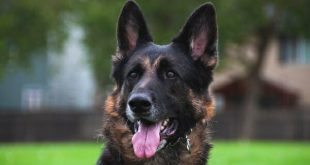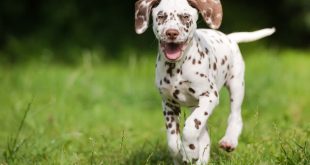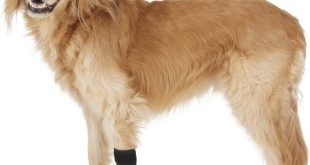It can be an alarming situation for any dog parent to find a bizarre-looking swelling on their pet. If this is the case, you might want to inform your veterinarian about this swelling to determine what it is.
In most cases concerning large dog breeds, this bulbous swelling may be an inflammatory response to repeated pressure called an elbow Hygroma. So, let’s educate you some more about hygromas before we proceed.
What is an Hygroma?
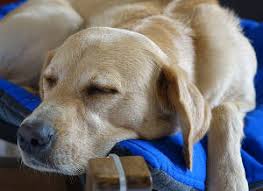
An Hygroma is a false bursa that develops around the joints of dogs. It disproportionately affects larger dog breeds such as Labrador retrievers, mastiffs, German shepherds and Great Danes. They are formed in response to repeated pressure.
Hygromas can form over any bony prominence on your dog’s body. Although the most common location for an hygroma is the elbow. Please note that Hygromas are not infectious or contagious to you and other pets.
It is just an inflammatory response to trauma, in the form of a fluid sac under the skin around your pet’s elbow. It is formed in between the bone and the skin.
At first, they are soft and small, and some may never grow enough to be noticed but some grow even larger and become hideous and hard.
Causes of Hygroma
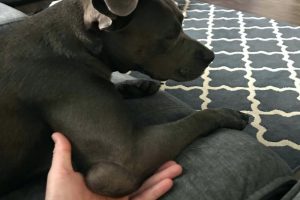
Some large breed dogs and dogs built for colder environments may prefer to lay down on the floor (especially hard tile surfaces) because it is much cooler than their beds. By doing this their elbows experience a lot of pressure and trauma which creates tissue damage over the elbow bones.
This area is unable to heal because of the repeated pressure the dog continuously exerts on his elbows every time it lays on a hard surface. Its body in an attempt to absorb this pressure creates its cushion in the form of a fluid pocket. This fluid pocket is called an Hygroma.
Hygromas is more likely to occur in larger dog breeds where more weight and pressure is exerted on the bony areas.
Diagnosing Hygromas
Your vet will conduct a complete physical examination of your dog and may even conduct a biopsy if any lesions look unusual.
Provide the necessary information to your vet such. This should include when you first noticed the swelling on your dog and any behavioral changes you have noticed.
When viewed microscopically fluid found in Hygromas tend to be yellowish-red. This is dependent on the degree of pressure and trauma. The fluid is less viscous than the joint fluid.
Hygroma can be classified into types. These are discussed below.
Uncomplicated Hygroma
This is the simple hygroma that is not infected and does not cause pain to your dog.
Complicated Hygroma
These types of Hygromas usually causes calluses in dogs and can become infected.
For instance, if the dog lays on a concrete floor and has cracks on its skin, bacteria may penetrate these resulting in an infection. This may manifest as an abscess (a painful collection of pus, usually caused by a bacterial infection).
Hygromas appear small and soft in the early stages where they are almost unnoticeable unless your vet points them out in a physical examination of your dog.
In the latter stages, they often harden become larger. Hygromas usually vary in size but can go up to 2 inches in diameter. If your dog has an Hygroma it should show no signs of a systemic illness and should not display pain when touched.
The presence of an hygroma over a long time may cause severe inflammation, ulceration, tissue erosion, granulomas fistulas infection.
When your dog’s hygroma becomes infected it causes pain to your dog and it becomes warm to the touch. It also causes discomfort to your dog and must be immediately dealt with.
If your dog’s hygroma is infected, you may notice the following.
- leaking fluid from the source
- Blackheads (small bumps on the skin surface due to clogged hair follicles) around the hygroma.
- Inflamed hair follicles at the site.
Treating Hygromas
A simple hygroma which is not infected and causes no pain can be treated in the following conservative ways;
- Changing your dog’s bedding. Change your dog’s bedding and ensure its soft and comfortable. This will reduce the trauma on its elbows whenever it lays down.
- Draining off the hygroma when it’s still small. Although this does not guarantee that it will not grow back, it can help to get rid of it in its early stages.
- If the Hygroma is still small, padding it can stop its progression and may also lead to its regression as well.
If your dog’s Hygroma does not resolve with the conservative treatment or antibiotics surgery may be required. But in general, hygromas are hard to heal especially for older dogs.
HOW TO WRAP A DOG HYGROMA
Step 1
Using a strong and flexible clinically approved bandage that does not stick to your dog’s fur, roll it around your dog’s hygroma. This will ensure that it adheres and stays just where you want. In case your dog has an irritation, you can apply a topical hotspot cream to soothe your dog.
Step 2
When wrapping your dog’s elbow, make sure your dog is in a standing position when applying the bandage. This is to ensure that it can get as high up as your dog’s axilla as possible. Also ensure that you use the appropriate bandage size. Generally, 1 or 2-inch tapes are used for small breed dogs, while 2 to 3-inch tapes are used for larger breed dogs.
Step 3
When wrapping your dog’s elbow, roll a bandage about three times over the affected area. Wrapping your dog’s elbow is also necessary after an hygroma-removal surgery. Using a material capable of stretching to accommodate casts and bandages while still allowing for a standard range of movement, after the surgery, gently wrap the opening up to prevent further infection from occurring. This will also stop your dog from biting, scratching, or pulling at wounds and stitches.
Step 4
Wrap the bandage around your dog’s legs several times and ensure that it has the right tension to prevent it from falling off. If the bandage is too loose, tighten it up a little bit until it just sits right.
Conclusion
Note that hygromas are not tumors. As an hygroma gets larger, the risks of complications can increase. Report any strange growth you notice on your dog to your vet as this could be immensely helpful in detecting and tackling an hygroma at an early stage.
 Total Pooch Dog Supplements, Tear Stain Removers, De-wormers, Tylosin for Dogs and other great products.
Total Pooch Dog Supplements, Tear Stain Removers, De-wormers, Tylosin for Dogs and other great products.
